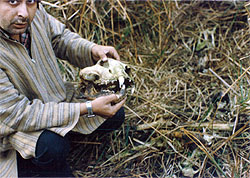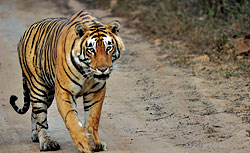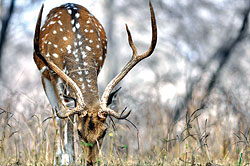It was summer of 1985, May 12th to be exact when our entire family had gone on a summer holiday to Mussourie. On 16th May we had a late start back home and after crossing Dehradun as we were about to cross Mohund, we saw a herd of elephants on the left flank from an elevated hill road. It was already past 5 p.m. while we stopped at Mohund Forest Chowki, to enquire about elephantsí presence. The information about forest and Rest House was enough to change our further course.
Making a necessary telephone call, for permission from the forest authorities in Dehradun, from the range office (there were no cell-phones those days), we veered our cars to the left - and entered Rajaji National Park for a night halt at Dhaulkhand.
Negotiating several dry river-beds and a rather long meandering forest stretch, we finally reached our destination: Dhaulkhand. The heart of Rajaji National Park, Dhaulkhand is now out of bounds for a common man being core area. The sheer raw beauty of Dhaulkhand touches you with the pristine natureís beauty. Nowadays, thanks to the stringent tourism policy in Indian forests, itís easier to gain entry in Rashtrapati Bhavan than in Dhaulkhand! We were, of course, lucky as entries were easy and there were hardly any families like us who were mad for wildlife to the extent to spend a night in the forest without preparations, electricity and other facilities. (I recently spent two enchanting days at Dhaulkhand during the last Holi, but more about that in a future article).
The Sun had already set in as we entered the forest rest house of Dhaulkhand and the ladies became busy cooking dinner on the firewood with the local rations picked up at Mohund. The muted chirping of the birds indicated that darkness had engulfed the forest. We took a jungle round and came across a beautiful male leopard on the stretch between Dhaulkhand and Beribarha Forest Rest House as also a lot of cheetal and sambhar herds as well as cattle in the forest. After the round we had dinner which was ready by then. We slept early, to wake up next morning with the break of dawn.
|


The true achievement will come when we are able to restore the forest corridor which has been ursurped by the so called development of homo sapiens in the form of mindless construction permissions, cutting up forest patch for Ashrams and agriculture and mindless jungle encroachment of Raiwala Ammunition Dump. Rajaji has better potential than even Corbett. It is said that Rajaji was the most favoured hunting ground of the erstwhile Raj and Britishers. It is said that they could hunt several tigers in one night in Dhaulkhand stretch of the park. |
An early morning drive through a forest at sunrise, is always enchanting, and it was more so in Dhaulkhand that particular summer. Within minutes, the whole jungle is busy in unison to fill up with food and water - as if to settle for the long day. Several herds of spotted dear hurtled in front of our car, occasional jungle fowl was scanning the loose earth foraging for food, and an occasional sambhar would break cover from the bushes to give a close look to our vehicle. The sunlight coming through the occasional thin tall Sal, Dhak, Rohini and Ber trees gave an almost magical appearance to the setting. The evening before a forest guard had given us a little description about forest roads to our nearby Hanicut (a kind of small dam for water storage) where there was maximum probability of finding wildlife.
While imbibing the indescribable beauty of the forest, I noticed a small group of vultures atop a tree. Maybe a kill was nearby, or even the killer! Could it be a tiger or a leopard, I wondered.
As any wildlife enthusiast will tell you, the very hint of a big catís presence in a jungle impacts the body, mind and spirit - all at once! For the next 25 minutes or so, all of us sat motionless in the car; straining our ears to catch any sound near the prey or an alarm call, a typical jungle phenomenon through which a tigerís or a leopardís presence gets advertised in the forest.
We heard nothing, absolutely nothing. The vultures too did not make any noticeable movement.
 Maybe the tiger was lying close to the kill, and the vultures were waiting patiently for him to move away, I told myself. Minutes dragged by, and still nothing happened. I then decided to do a little investigation, moved out and had hardly walked 50 metres through the grass and bush patch in the direction the vultures were pointed towards, when a sight stopped me in my tracks. My body froze with a frightening shiver. It was a tiger which I saw lying out of grass- no more than 10 metres from me! Any abrupt movement on my part could make the tiger come straight for my jugularÖ.But the tiger did not make any movement. I slowly and stealthily started retracting my steps. Disturbing a tiger on its kill is to surely invite death. Maybe the tiger was lying close to the kill, and the vultures were waiting patiently for him to move away, I told myself. Minutes dragged by, and still nothing happened. I then decided to do a little investigation, moved out and had hardly walked 50 metres through the grass and bush patch in the direction the vultures were pointed towards, when a sight stopped me in my tracks. My body froze with a frightening shiver. It was a tiger which I saw lying out of grass- no more than 10 metres from me! Any abrupt movement on my part could make the tiger come straight for my jugularÖ.But the tiger did not make any movement. I slowly and stealthily started retracting my steps. Disturbing a tiger on its kill is to surely invite death.
Despite the obvious danger I had put myself to, as I entered inside the car, I regained my composure and started assessing. The tigerís strange behavior got me thinking. After gathering courage, I gave out a coughing sound... The tiger still did not move... then we all made a lot of noise... But the tiger remained unresponsive. It did not even move from the point it was lying. Keeping ourselves safe we tried every method that could make the tiger stand up and then decided to give a second close look and while making sounds with every step taken we started moving close to the point step by step to where the tiger was lying. This time, having reached within 5 meters, in a flash, excitement gave way to pangs of sadness. Almost instinctively, I knew what had happened. All along we had been watching a dead tiger! It was a handsome young tigeress, in the prime of her youth. Not a single injury mark was visible on its body. I wondered whether it had been poisoned and decided, then and there, to do something about it. To investigate I moved to nearby tribal gypsy Vadas (thatched huts) to understand what happens if their cattle are lifted by tigers or panthers - as it was my forest knowledge gained that carcasses are poisoned to get rid of the menace.
What to do now? We came back to the Forest Rest House and debated whether we should inform the forest department and entire family including ladies and children gets involved in the investigations or to move out. Finally it was decided that the entire family would move away to Delhi and would take up the matter with the authorities and media. By afternoon we all packed up and moved and gave a last look to the tiger. It was strange that as we left the dead tigress the vultures and jackals had almost cleared the carcass within hours.
Reaching Delhi, I wrote about the episode in The Hindustan Times and the Times of India. All hell broke loose after my report about the dead tiger with the photographs was published in the front page with the fact that it had possibly been poisoned.
Rajaji Parkís Warden, Mr. V K Verma, was quick to refute my news-report. He claimed there was no dead tiger in the park and denied the death due to rising man-animal conflicts, which I had mentioned in my article. But within days, as Mr. Verma, after having conducted his own inquiry, could not locate the carcass, I was called to show the location. Fortunately I succeeded and came across the carcass of tiger and it was subsequently concluded that it had possibly been poisoned. I stood vindicated.
Thereafter, I developed a cordial relation with Mr. Verma, and found him to be a dedicated and involved forest officer.
The next few years were the hardest on Rajajiís tigers. Most, if not all, vanished without a traceÖI wondered, then, whether the beautiful park would be deprived of its tigers as victims of human greed which was taking a toll on the wildlife in other parts of India as well.
But a series of developments made me realize that things were not as bad as they looked initially. The relocation of a large number of families living inside Rajaji Park to Pathri and other blocks near Haridwar brought the winds of change to the beleaguered park. The forests of Rajaji, I am proud to report, are springing back to its original glory. The tiger, too, has returned and their sightings are getting common in Dhaulkhand and especially Chilla ranges. During my last visit to Rajaji I came across several pug marks and a beautiful huge male tiger near now renovated Khara Forest Bunglow (see photo).
A new recovery of a patient whom I had given up for dead... but had kept our fight on for its revival...
|